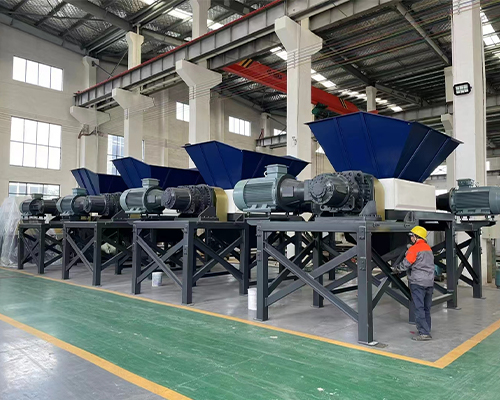Dual shaft shredder development prospects
The development prospects for dual-shaft shredders are promising due to their versatility, efficiency, and adaptability to various waste processing needs. Here are some key areas where advancements and growth are expected:
1. Technological Advancements
Improved Blade Design: Enhanced blade geometry can lead to more efficient cutting and reduced wear, extending the life of the shredder.
Material Science: Development of stronger and more durable materials for components like blades and gears will improve performance and longevity.
Automation and IoT Integration: Integration with Internet of Things (IoT) technologies can enable remote monitoring, predictive maintenance, and optimized operation.
2. Environmental Regulations and Sustainability
Recycling Initiatives: Stricter recycling regulations and increased focus on sustainability will drive demand for efficient waste processing equipment.
Waste-to-Energy Solutions: Dual-shaft shredders can play a crucial role in preparing waste for energy recovery processes, such as incineration and gasification.
3. Market Expansion
Industrial Applications: Growing industries such as construction, automotive, and electronics will require more robust waste management solutions.
Municipal Waste Management: Municipalities are increasingly adopting advanced waste processing technologies to manage growing volumes of municipal solid waste.
Global Markets: Emerging markets in Asia, Africa, and Latin America are seeing rapid urbanization and industrialization, creating new opportunities for waste processing equipment.
4. Customization and Flexibility
Modular Designs: Modular and customizable shredders can be tailored to specific applications, improving efficiency and reducing costs.
Quick-Change Devices: Features like quick-change devices for shredding elements allow for easy maintenance and adaptation to different materials.
5. Energy Efficiency
Optimized Motor Systems: More efficient motors and drive systems can reduce energy consumption and operating costs.
Regenerative Systems: Implementation of regenerative braking systems can capture and reuse energy generated during the shredding process.
6. Safety and Reliability
Enhanced Safety Features: Advanced safety mechanisms, such as emergency stop systems and sensor-based monitoring, will enhance user safety.
Robust Construction: Improved design and manufacturing processes will ensure higher reliability and longer operational lifespans.
7. Innovative Applications
Biomass Processing: Dual-shaft shredders can be used to prepare biomass for bioenergy production, contributing to renewable energy goals.
Plastic Recycling: With the increasing focus on plastic waste, dual-shaft shredders can play a vital role in preparing plastics for recycling and repurposing.
8. Economic Factors
Cost Reduction: Advances in technology and manufacturing can lead to lower production costs, making dual-shaft shredders more affordable and accessible.
Government Incentives: Government incentives and subsidies for waste management and recycling initiatives can boost market adoption.
Conclusion

The future of dual-shaft shredders looks bright, driven by technological innovations, environmental concerns, and economic factors. As these machines continue to evolve, they will play an increasingly important role in sustainable waste management and resource recovery.
| Model | 600 | 800 | 1000 | 1200 | 1400 | 1600 | 1800 |
| Motor(kw) | 11*2 | 18.5*2 | 35*2 | 45*2 | 55*2 | 75*2 | 110*2 |
Reducer | P6-P7 | P7-P8 | P8-P10 | P10-P12 | P11-P13 | P12-P16 | P14-P16 |
| Siemens or other motors, planetary reducers or other reducers can be customized according to customer requirements | |||||||
| Rotation Speed | 8-20rmp | 8-20rmp | 8-15rmp | 8-15rmp | 8-15rmp | 8-12rmp | 8-12rmp |
| Blades Diameter | 220-320 | 260-320 | 260-400 | 400-500 | 400-500 | 500 | 500 |
| Blades material | The material of the blades (55sicr, 5crsi, 9crsi, skd11, m6v, h13) can be customizedaccording to the customer's actual usage | ||||||
| Feeding Size | 1200*900mm | 1400*1000mm | 1600*1200mm | 1800*1300mm | 2000*1300mm | 2200*1700mm | 2400*2000mm |
| The size and appearance of the feeding hopper can be customized according to thecustomer's feeding situation | |||||||
| Weight(kg) | 1800 | 2500 | 3700 | 5500 | 7500 | 9500 | 13000 |
-
 Trommel screenTrommel screen, also known as drum screens, are widely used in various industries for sorting and separating materials.Get Quote
Trommel screenTrommel screen, also known as drum screens, are widely used in various industries for sorting and separating materials.Get Quote -
 Crop straw double shaft shreddApplications:Biomass Energy Production: Shredded straw can be used as a feedstock for bioenergy plants to produce electricity or heat.Livestock Feed: Reduced-si...Get Quote
Crop straw double shaft shreddApplications:Biomass Energy Production: Shredded straw can be used as a feedstock for bioenergy plants to produce electricity or heat.Livestock Feed: Reduced-si...Get Quote -
 Zhongcheng Air Drum SeparatorAir drum separators effectively separate lightweight materials (e.g., plastics, paper) from heavier materials (e.g., metals, glass). This high efficiency is cru...Get Quote
Zhongcheng Air Drum SeparatorAir drum separators effectively separate lightweight materials (e.g., plastics, paper) from heavier materials (e.g., metals, glass). This high efficiency is cru...Get Quote
-
2023-01-12Horizontal Semi-Auto Hydraulic BalerSemi automatic balers are used across the logistics, recycling and manufacturing sectors to process large volumes of waste materials such as cardboard, film, pa...
-
2023-01-12Double-Shaft ShredderThe Double-shaft shredder is a widely used industrial shredder that efficiently processes various mixed waste materials, such as construction waste, industrial ...
-
2024-08-06Plastic double shaft shredderOperation:Feeding: The plastic material is fed into the shredder through the infeed system.Shredding: As the material enters the shredding chamber, the rotating...
-
2023-01-18Metal BalerMetal baler, specifically a hydraulic metal baler, is a machine designed to compress scrap metal into dense, manageable bales. This equipment is widely used in ...
-
2024-05-18C Series Jaw CrusherC series jaw crusher is a jaw crusher with excellent performance introduced and developed by zchmachinery according to the market demand. Compared with traditio...



